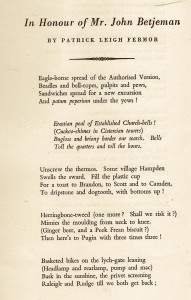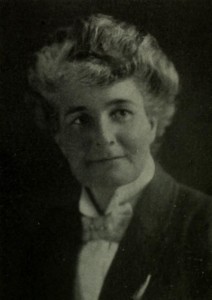This is a useful pocket guide to some extent, but is frequently supercilious and downright patronising. Often the compiler treats the reader as if they were a halfwit, especially in the matter of pronunciation.’ Reindeer is pronounced rain-deer ‘ it advises. ‘ Salver is pronounced sal-ver, not sar-ver’, apparently. Then it warns readers not to confuse one word with another with a similar spelling. Thus ‘ corpse ‘ should not be confused with corps. Nor should anyone write continential ( which doesn’t exist as a word ) when they mean continental ? Has anyone ever done that ?
The corrected pronunciation of some words is questionable, to say the least. We are told that with ‘ abdomen’ , the emphasis should be on the second syllable, not the first . With ‘ mediocre ‘the first syllable should feature a short ‘e’. Today, there is no agreement on these two examples. In other instances the suggested pronunciation is bonkers. The word ‘retch ‘ according to this book, should be pronounced ‘ reach’. ‘Rabies has three syllables ‘we are informed, and should be pronounced rar bee ez. Sheer madness! Even if the word has a foreign derivation, by 1888 its place in the English language should have been assured. Disappointingly, it has nothing to say about the vexed question of whether ‘poor ‘ should be pronounced poo-er, as some grammarians insisted, or ‘pore’. Ghost-writer M. R. James famously derided those who favoured the latter pronunciation in his story ‘The Mezzotint ‘. But doubtless the Provost of Eton was a bit of a snob. Nor does the Dictionary suggest how ‘economics ‘ or ‘controversy ‘ should be pronounced. It ought to come down heavily on two of the worst solecisms of our own time, ‘less’ for ‘fewer’ and ‘reticent’ for reluctant, but it doesn’t. However, it is good to see that in 1888, 34 years before the BBC was founded, and many years before newspapers had a role in forming popular opinion, we are told that the plural of ‘medium’ is ‘media’. It is also interesting to note that back in 1888 common speech was as plagued as it is today with the ubiquitous ‘ you know ‘. ‘All these “ you knows “ would be better left out ‘ advises our author. Quite.
Disappointingly, and indeed, rather predictably, the booklet perpetuates the grammatical correctness of the gendered pronoun, as in the correction to ‘I do not think anyone to blame for taking care of their health’. ‘Their’ should be ‘his’, it advises, rather chauvinistically. Today, you don’t have to be a feminist to prefer the use of the gender-free ‘their‘ in this case.
All in all, A Dictionary of Daily Blunders contains almost as many blunders masquerading as truths as it does corrections to perceived blunders. No wonder the author, who also compiled A Handy Book of Synonyms,wanted to remain anonymous.
[R.M.Healey]


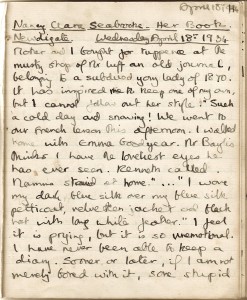
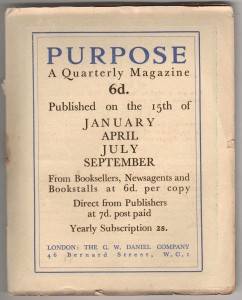
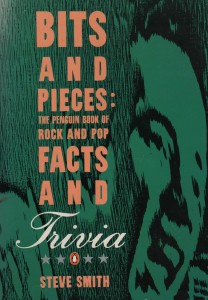

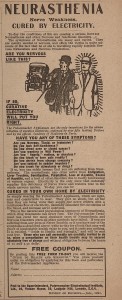
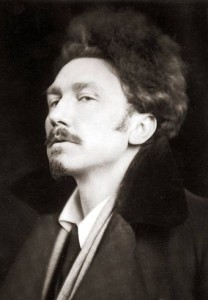 It’s often enlightening to read very early reviews of major writers, especially modernist writers. In 2019 we have the benefit of knowing how certain ‘ big names ‘ developed and influenced others, while the innocent reviewer of an early work has only the words on a page. A gifted reviewer may sense that a writer under review is destined for greatness, but most reviewers are hacks and care little. In the case of Ezra Pound, the anonymous review of his third collection, Personaethat appeared in The Literary Worldof August 15th1909, suggests that the reviewer was already an admirer of his first two collections, A Lume Spento(1908), which had been privately printed in Venice in a tiny edition of just 150 copies, but which Pound had persuaded the London bookseller Elkin Matthews to display in his window—and the follow up, A Quinzaine for this Yule—also in a tiny edition. A London Evening Standardreviewer described the former as ‘wild and haunting stuff, absolutely poetic, original, imaginative, passionate and spiritual’. It seems that the Literary World reviewer was of a similar mind:
It’s often enlightening to read very early reviews of major writers, especially modernist writers. In 2019 we have the benefit of knowing how certain ‘ big names ‘ developed and influenced others, while the innocent reviewer of an early work has only the words on a page. A gifted reviewer may sense that a writer under review is destined for greatness, but most reviewers are hacks and care little. In the case of Ezra Pound, the anonymous review of his third collection, Personaethat appeared in The Literary Worldof August 15th1909, suggests that the reviewer was already an admirer of his first two collections, A Lume Spento(1908), which had been privately printed in Venice in a tiny edition of just 150 copies, but which Pound had persuaded the London bookseller Elkin Matthews to display in his window—and the follow up, A Quinzaine for this Yule—also in a tiny edition. A London Evening Standardreviewer described the former as ‘wild and haunting stuff, absolutely poetic, original, imaginative, passionate and spiritual’. It seems that the Literary World reviewer was of a similar mind: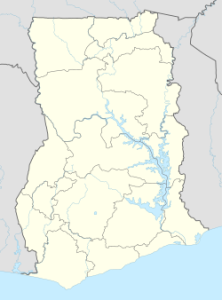
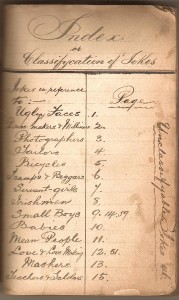 Found at Jot HQ the other day a small scrapbook containing pasted in humorous cuttings from magazines and newspapers that once belonged to the late prankster Jeremy Beadle (1948 – 2008). The date 1897 on the cover was very likely the year in which the compilation was begun, since many of the jokes and anecdotes are clearly of a later date. The high quality of much of the material strongly suggests that the compiler may have been a comedian of some sophistication who was prepared to devote a long period in search of the best gags.
Found at Jot HQ the other day a small scrapbook containing pasted in humorous cuttings from magazines and newspapers that once belonged to the late prankster Jeremy Beadle (1948 – 2008). The date 1897 on the cover was very likely the year in which the compilation was begun, since many of the jokes and anecdotes are clearly of a later date. The high quality of much of the material strongly suggests that the compiler may have been a comedian of some sophistication who was prepared to devote a long period in search of the best gags.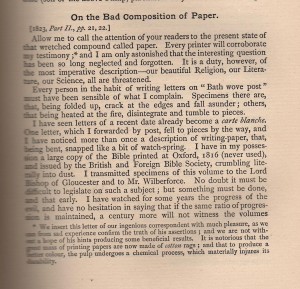 Researchers in newspaper and magazine archives often complain about the horrendous quality of newsprint they encounter. Sometimes whole pages are brown and need to be handled with extraordinary care as they are turned, lest they crumble to dust— to the embarrassment of the researcher. The decline of paper quality seems to have begun towards the end of the nineteenth century and is attributed to the high acid content of the wood pulp used for printing cheap publications—mainly newspapers and periodicals, particularly adventure and school stories for boys, but also mass produced books issued in serial form. The decay of newsprint appears to accelerate with exposure to sunlight, which explains why single issues of newspapers and magazines are much more likely to turn brown and crumble than bound volumes.
Researchers in newspaper and magazine archives often complain about the horrendous quality of newsprint they encounter. Sometimes whole pages are brown and need to be handled with extraordinary care as they are turned, lest they crumble to dust— to the embarrassment of the researcher. The decline of paper quality seems to have begun towards the end of the nineteenth century and is attributed to the high acid content of the wood pulp used for printing cheap publications—mainly newspapers and periodicals, particularly adventure and school stories for boys, but also mass produced books issued in serial form. The decay of newsprint appears to accelerate with exposure to sunlight, which explains why single issues of newspapers and magazines are much more likely to turn brown and crumble than bound volumes.
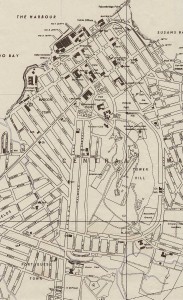
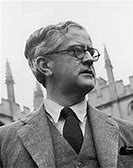

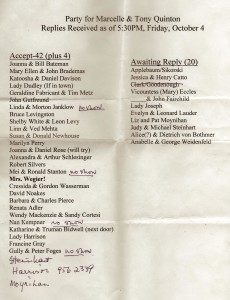 Found among papers at Jot HQ ( heaven knows where it came from ) is this printed list of the good and great ( some not so good) who were invited by a friend or friends to attend a party for the philosopher (Lord)
Found among papers at Jot HQ ( heaven knows where it came from ) is this printed list of the good and great ( some not so good) who were invited by a friend or friends to attend a party for the philosopher (Lord) 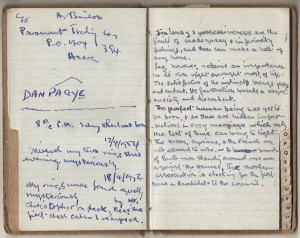 This fragmentary, though fascinating Diary, that occupies a section of a tiny Address Book, was found in the Jot HQ archives. It records a visit to west Africa in the first few months of 1954 by an anonymous male diarist whose remark that Africa’s dry season of Harmattan was ‘our winter ‘ suggests that he may have been a native African or have had African heritage. He also mentions visiting his mother in Ghana. Moreover, a solo entry in the Address Book dated two years before the Diary mentions ‘ English lessons ‘, and the erratic spelling and awkward grammar of the Diary entries are also strongly suggestive.
This fragmentary, though fascinating Diary, that occupies a section of a tiny Address Book, was found in the Jot HQ archives. It records a visit to west Africa in the first few months of 1954 by an anonymous male diarist whose remark that Africa’s dry season of Harmattan was ‘our winter ‘ suggests that he may have been a native African or have had African heritage. He also mentions visiting his mother in Ghana. Moreover, a solo entry in the Address Book dated two years before the Diary mentions ‘ English lessons ‘, and the erratic spelling and awkward grammar of the Diary entries are also strongly suggestive.